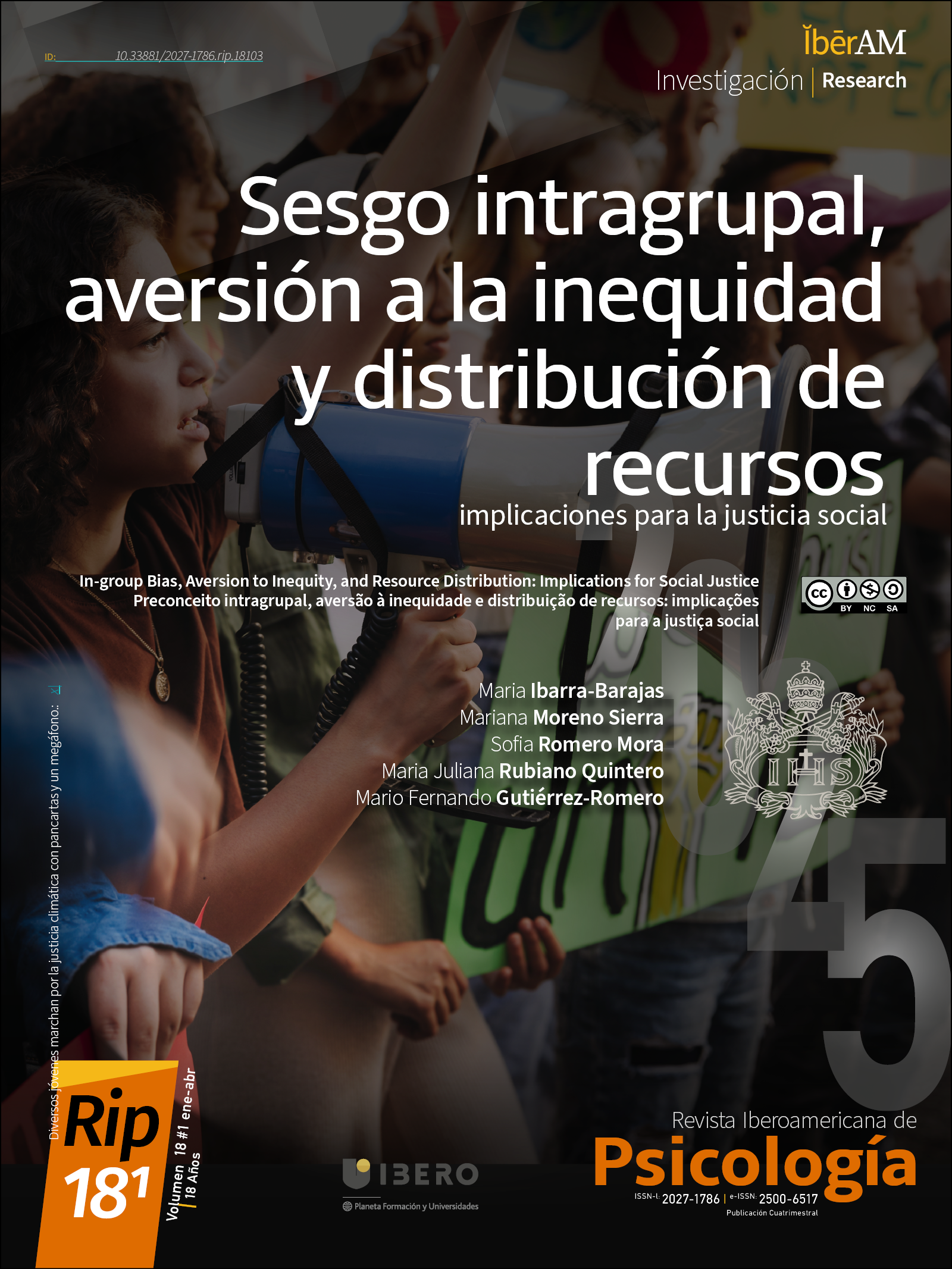Sesgo intragrupal, aversión a la inequidad y distribución de recursos implicaciones para la justicia social
In-group Bias, Aversion to Inequity, and Resource Distribution: Implications for Social Justice
Contenido principal del artículo
El objetivo de este artículo es explorar la relación entre aversión a la inequidad, distribución de recursos y sesgo intragrupal en escolares desde una perspectiva del desarrollo y establecer la relación entre variables socioeducativas y la respuesta aversiva. Participaron 302 personas entre los 11 y los 23 años (M = 16.45, DE = 2.95); se propuso una tarea que evaluaba la acepción o rechazo de distribuciones de recursos condicionadas por la presencia o ausencia de sesgo intragrupal. En los resultados se evidencia que el sesgo intragrupal genera diferencias significativas cuando las personas distribuyen recursos; existe una correlación negativa entre la aversión a la inequidad ventajosa y el número de monedas ofrecidas. Se prefiere mantener sus ganancias que tener que distribuirlos ante situaciones de inequidad. Este patrón sugiere que las relaciones interpersonales influyen en la distribución de recursos y reflejan un comportamiento adaptativo que busca mantener la cooperación y el orden dentro del grupo. Se halló una relación entre el estrato socioeconómico y una baja aversión a la inequidad desventajosa en presencia de la condición de sesgo intrasocial. Como conclusión se propone que el sesgo intragrupal influye en la distribución de recursos, a nivel social, el no cuestionarse si una distribución de recursos es justa o no, conlleva al mantenimiento de inequidad y desigualdad. El hecho de que las personas estén dispuestas a aceptar cualquier resultado con tal de obtener una ganancia implica que no existe un pensamiento crítico frente a la justicia.
Datos de publicación
Perfil evaluadores/as N/D
Declaraciones de autoría
- Sociedad académica
- Bogotá: Corporación Universitaria Iberoamericana
- Editorial
- Bogotá: Corporación Universitaria Iberoamericana
Detalles del artículo
Bardsley, N. (2008). Dictator game giving: altruism or artefact?. Experimental Economics, 11(2), 122-133. https://doi.org/10.1007/s10683-007-9172-2 DOI: https://doi.org/10.1007/s10683-007-9172-2
Binns, R. (2018, January). Fairness in machine learning: Lessons from political philosophy. Proceedings of Machine Learning Research, 81, 1-11. http://proceedings.mlr.press/v81/binns18a.html
Boun My, K., Lampach, N., Lefebvre, M., & Magnani, J. (2018). Effects of gain-loss frames on advantageous inequality aversion. Journal of the Economic Science Association, 4(2), 99-109. https://doi.org/10.1007/s40881-018-0057-2 DOI: https://doi.org/10.1007/s40881-018-0057-2
Brosnan, S. F. (2006). Nonhuman species’ reactions to inequity and their implications for fairness. Social Justice Research, 19(2), 153-185. https://doi.org/10.1007/PL00022136 DOI: https://doi.org/10.1007/PL00022136
Bucca, M. (2016). Merit and blame in unequal societies: Explaining Latin Americans’ beliefs about wealth and poverty. Research in Social Stratification and Mobility, 44, 98-112. https://doi.org/10.1016/j.rssm.2016.02.005 DOI: https://doi.org/10.1016/j.rssm.2016.02.005
Cohen, J. (1988). Set correlation and contingency tables. Applied psychological measurement, 12(4), 425-434. https://conservancy.umn.edu/bitstream/handle/11299/104317/1/v12n4p425.pdf DOI: https://doi.org/10.1177/014662168801200410
Corbit, J., McAuliffe, K., Callaghan, T. C., Blake, P. R., & Warneken, F. (2017). Children’s collaboration induces fairness rather than generosity. Cognition, 168, 344-356. http://dx.doi.org/10.1016/j.cognition.2017.07.006 DOI: https://doi.org/10.1016/j.cognition.2017.07.006
DANE. (2023). Tasa de desempleo en Colombia. https://www.dane.gov.co/index.php/estadisticas-por-tema/mercado-laboral/empleo-y-desempleo#:~:text=Informaci%C3%B3n%20enero%202024,2023%20(13%2C7%25).
Engelmann, J. M., Clift, J. B., Herrmann, E. & Tomasello, M. (2017). Social disappointment explains chimpanzees’ behaviour in the inequity aversion task. Proceedings of the Royal Society B: Biological Sciences, 284(1861), 20171502. doi: 10.1098/rspb.2017.1502 DOI: https://doi.org/10.1098/rspb.2017.1502
Fehr, E., & Schmidt, K. M. (1999). A theory of fairness, competition, and cooperation. The Quarterly Journal of Economics, 114(3), 817–868. http://dx.doi.org/10.1162/003355399556151 DOI: https://doi.org/10.1162/003355399556151
Friedl, A., Pondorfer, A., & Schmidt, U. (2020). Gender differences in social risk taking. Journal of Economic Psychology, 77, 102182. https://doi.org/10.1016/j.joep.2019.06.005 DOI: https://doi.org/10.1016/j.joep.2019.06.005
Gaither, S. E., Perlin, J. D., & Doan, S. N. (2020). Race, gender, and the development of cross-race egalitarianism. Frontiers in Psychology, 11:1525. https://doi.org/10.3389/fpsyg.2020.01525 DOI: https://doi.org/10.3389/fpsyg.2020.01525
Gómez, M. S., Galvis-Aponte, L. A., & Royuela, V. (2015). Calidad de vida laboral en Colombia: un índice multidimensional difuso. Research Institute of Applied Economics. Universitat de Barcelona.
Grocke, P., Rossano, F., & Tomasello, M. (2015). Procedural justice in children: preschoolers accept unequal resource distributions if the procedure provides equal opportunities. J. Exp. Child Psychol. 140, 197–210. DOI: 10.1016/j.jecp.2015.07.00 DOI: https://doi.org/10.1016/j.jecp.2015.07.008
Harris, A., Young, A., Hughson, L., Green, D., Doan, S. N., Hughson, E., & Reed, C. L. (2020). Perceived relative social status and cognitive load influence acceptance of unfair offers in the Ultimatum Game. PLOS ONE, 15(1), e0227717. https://doi.org/10.1371/journal.pone.0227717 DOI: https://doi.org/10.1371/journal.pone.0227717
Hayashi, H. (2020). Do 5- and 6-year-old children attempt to appear to others?. The Journal of Genetic Psychology, 191(2-3), 1-9. doi: 10.1080/00221325.2020.1738321 DOI: https://doi.org/10.1080/00221325.2020.1738321
Hepach, R., Vaish, A., & Tomasello, M. (2013). A new look at children’s prosocial motivation. Infancy, 18(1), 67-90. DOI: 10.1111/j.1532-7078.2012.00130.x DOI: https://doi.org/10.1111/j.1532-7078.2012.00130.x
Heuer, L., & Stroessner, S. J. (2011). The multi-value basis of procedural justice. Journal of Experimental Social Psychology, 47(3), 541-553. https://doi.org/10.1016/j.jesp.2011.01.007 DOI: https://doi.org/10.1016/j.jesp.2011.01.007
Hewstone, M., Rubin, M., & Willis, H. (2002). Intergroup bias. Annual Review of Psychology, 53(1), 575–604. https://doi.org/10.1146/annurev.psych.53.100901.135109 DOI: https://doi.org/10.1146/annurev.psych.53.100901.135109
McAuliffe, K., Blake, P. R., Kim, G., Wrangham, R. W., & Warneken, F. (2013). Social influences on inequity aversion in children. PloS One, 8(12), e80966. doi:10.1371/journal.pone.0080966 DOI: https://doi.org/10.1371/journal.pone.0080966
Myers, D. G., & Smith, S. M. (2012). Exploring social psychology. New York: McGraw-Hill.
Oberliessen, L., & Kalenscher, T. (2019). Social and non-social mechanisms of inequity aversion in non-human animals. Frontiers in Behavioral Neuroscience, 13(133), 1-11. https://doi.org/10.3389/fnbeh.2019.00133 DOI: https://doi.org/10.3389/fnbeh.2019.00133
O'Driscoll, D., Taylor, L. K., & Dautel, J. B. (2018). Intergroup resource distribution among children living in segregated neighborhoods amid protracted conflict. Peace and Conflict: Journal of Peace Psychology, 24(4), 464 – 474. http://dx.doi.org/10.1037/pac0000348 DOI: https://doi.org/10.1037/pac0000348
Qiu, X., Yu, J., Li, T., Cheng, N., & Zhu, L. (2017). Children’s inequity aversion in procedural justice context: A comparison of advantageous and disadvantageous inequity. Frontiers in Psychology, 8, 1855. https://doi.org/10.3389/fpsyg.2017.01855 DOI: https://doi.org/10.3389/fpsyg.2017.01855
Rakoczy, H., Kaufmann, M., & Lohse, K. (2016). Young children understand the normative force of standards of equal resource distribution. Journal of Experimental Child Psychology, 150, 396-403. https://doi.org/10.1016/j.jecp.2016.05.015 DOI: https://doi.org/10.1016/j.jecp.2016.05.015
Renno, M. P., & Shutts, K. (2015). Children’s social category-based giving and its correlates: Expectations and preferences. Developmental Psychology, 51, 533–543. http://dx.doi.org/10.1037/a0038819 DOI: https://doi.org/10.1037/a0038819
Rutland, A., Killen, M., & Abrams, D. (2010). A new social-cognitive developmental perspective on prejudice: The interplay between morality and group identity. Perspectives on Psychological Science, 5, 279–291. http://dx.doi.org/10.1177/1745691610369468 DOI: https://doi.org/10.1177/1745691610369468
Schokkaert, E., & Tarroux, B. (2021). Empirical research on ethical preferences: how popular is prioritarianism?. GATE WP. http://dx.doi.org/10.2139/ssrn.3766216 DOI: https://doi.org/10.2139/ssrn.3766216
Strangor, C., Jhangiani, R., & Tarry, H. (2022). Principles of Social Psychology (1st international H5P edition). BCcampus. https://opentextbc.ca/socialpsychology/
Takagishi, H., Kameshima, S., Schug, J., Koizumi, M., & Yamagishi, T. (2010). Theory of mind enhances preference for fairness. Journal of Experimental Child Psychology, 105(1-2), 130-137. https://doi.org/10.1016/j.jecp.2009.09.005 DOI: https://doi.org/10.1016/j.jecp.2009.09.005
Tsoi, L., & McAuliffe, K. (2019). Individual differences in theory of mind predict inequity aversion in children. Personality and Social Psychology Bulletin, 46(4) 559–571. doi:10.1177/0146167219867957 DOI: https://doi.org/10.1177/0146167219867957
Vale, G. L., & Brosnan, S. F. (2017). Inequity Aversion. In J. Vonk & T. K. Shackelford (Eds.), Encyclopedia of Animal Cognition and Behavior. Springer International Publishing. https://doi.org/10.1007/978-3-319-47829-6_1084-1 DOI: https://doi.org/10.1007/978-3-319-47829-6_1084-1
Warner, C. H., Fortin, M., & Melkonian, T. (2024). When are we more ethical? A review and categorization of the factors influencing dual-process ethical decision-making. Journal of Business Ethics, 189(4), 843-882. https://doi.org/10.1007/s10551-022-05281-0 DOI: https://doi.org/10.1007/s10551-022-05281-0
Williams, A., & Moore, C. (2014). Exploring disadvantageous inequality aversion in children: how cost and discrepancy influence decision-making. Frontiers in Psychology, 5, 1-6. https://doi.org/10.3389/fpsyg.2014.01088 DOI: https://doi.org/10.3389/fpsyg.2014.01088
Williams, A., & Moore, C. (2016). A longitudinal exploration of advantageous and disadvantageous inequality aversion in children. Journal of Experimental Child Psychology, 152, pp. 294-306. https://doi.org/10.1016/j.jecp.2016.07.006 DOI: https://doi.org/10.1016/j.jecp.2016.07.006
Yu, J., Zhu, L., & Leslie, A. (2016). Children’s sharing behavior in mini-dictator games: the role of in-group favoritism and theory of mind. Child Development, 87(6), p. 1747-1757. https://doi.org/10.1111/cdev.12635 DOI: https://doi.org/10.1111/cdev.12635
Zin, G., Escobal, G., Esteves, G., & Goyos, C. (2015). Sharing Game: Influence of gender, cost of response, history of reinforcement, and amount of money in the resource distribution of undergraduate students. Behavior Analysis: Research and Practice, 15(1), 65–80. https://doi.org/10.1037/h0101071 DOI: https://doi.org/10.1037/h0101071












